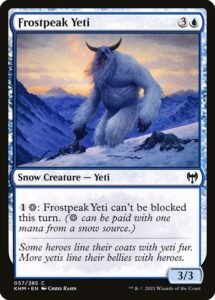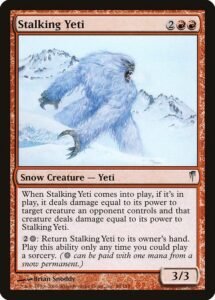
Dinanthropoides Nivalis
It showed up dark against the snow, and as far as I could make out, wore no clothes.
–N.A. Tombazi, Royal Geographical Society photographer
Many ancient Tibetans worshipped a being known as mi rgod, a term that translates to “wild man.” The Lepecha people of the Himalayas called him chu mung, which means “glacier man.” This entity traversed the highest mountains in the world, toting a stone weapon and creating a whistling sound.
Modern humans know “glacier man” by a more famous moniker: yeti. Etymologists believe this word derives from the Tibetan yachê. This name is a compound of ya, which means “rocky place,” and chê, which means “bear.”
For centuries, the “bear of the rocky place” lived vividly in the region’s lore, but scientists dismissed its existence. As the 20th century brought mountaineers to the Himalayas to ascend to the planet’s apex, strange experiences began to accumulate. Sightings of large beings bounding through the snow. Behemoth footprints. Was Glacier Man a real being?
Remarkably, irrefutable evidence of the yeti’s existence soon began to proliferate. Living in the mountains of Asia was the first discovery of an unknown bipedal hominid in many moons.

In 1925, a photographer for the Royal Geographical Society, N.A. Tombazi, witnessed a creature near the Zemu Glacier at the base of Kangchenjunga, the world’s third-highest peak. At 15,000 feet, he spied a beast whose outline “was exactly like a human being, walking upright and stopping occasionally to pull up some dwarf rhododendron bushes.” He noted it “showed up dark against the snow” and could not have been a human because it wore no clothing.
In 1937, mountaineer Frank Smythe encountered some of the best evidence of the yeti’s existence. Published in Popular Science, Smythe snapped a distinct photo of what are clearly yeti footprints.

The footprint proof continued to pile up.
In 1944, mountaineer C.R. Cooke found yeti prints in mud. Another climber, Eric Shipton, discovered in 1951 massive prints in the snow; the feet were as big as a pickaxe. Both treks obtained photographic documentation.
By the time Tenzing Norgay and Edmund Hillary summited Everest for the first time in 1953, their reports of footprints on the mountain came as no surprise. Seven years later, Hillary launched a voyage to the nearby Rolwaling Valley for the expressed purpose of finding a yeti. This location had been the home of Shipton’s footprint images.



Sightings and prints, however, do not a confirmation make.
Fortunately, physical evidence of the creature surfaced. At a monastery in a village named Pangboche, lamas preserved two yeti body parts. These pieces had been procured in the past by Lama Sangwa Dorje, who went to a cave to meditate. A yeti discovered the man, and he was so impressed with his meditation that he decided to bring him food, water, and fuel for a fire. The two interacted for so long that the yeti became a Buddhist disciple. When the yeti perished, Dorje took the creature’s scalp and hand to keep as relics in the monastery.
In 1957, a Texan oilman and adventurer named Tom Slick visited the monastery to view the relics. He managed to snap some photos of the hand, but the lamas resisted its removal for scientific study. Two years later, on another visit, a member of Slick’s entourage stole parts of the hand, hoping to move it to England for examination. To pull off the stunt, they enlisted Jimmy Stewart – the star of It’s a Wonderful Life, Rear Window, and Vertigo – to smuggle the hand in his wife’s undergarments as they passed through airport security.
Slick and Stewart might have employed a less audacious endeavor by bringing scientists to the hand, as had occurred with the scalp in earlier years. This more straightforward possibility lacks the daring combination of fossils and brassieres, however.



A second scalp, pictured above, surfaced at another monastery.
This combination of physical evidence served as the silver bullet for which hunters had searched. The veracity of the yeti became a verified fact.
Biologists classified the yeti as Dinanthropoides nivalis. This scientific nomenclature reflects several key points about the yeti. The genus Dinanthropoides combines the Greek words deinos – “terrible” or “formidable” – anthrōpos – “human” – and the suffix oides – “likeness” or “similar.” The species name comes from the Latin word for “snowy” or “pertaining to snow.” Put them together and we get Formidable Human-like Creature of the Snow.
Another popular name for the yeti is Abominable Snowman. This term likely arrives from a twisting tale of mistranslation, poor hearing, or a combination thereof. In 1921, on the famous British Mount Everest reconnaissance expedition, Charles Howard-Bury and team encountered some yeti footprints. Sherpa guides informed Howard-Bury that the creature’s name was metoh-kangmi, which they summarized as “Wild Man of the Snows.” The strict translation of these Tibetan words are “man-bear” and “snowman.” Later, a writer named Henry Newman interviewed members of this expedition. After hearing the tale, he misheard or mistranslated the word metoh, transforming “man-bear” into “filthy.” When he donned a thesaurus, he found Filthy Snowman did not have the same ring as Abominable Snowman. By the time he discovered his translational mistake, he quite enjoyed the name and sent it off to newspapers. The nickname stuck.
Many anthropologists have noted similarities between the builds of yetis and the sasquatch, also known as bigfoot, said to reside in the forests of North America. Unlike, the yeti, no irreproachable evidence for the reality of bigfoot yet exists. Photographs of Dinanthropoides nivalis elevate it from the realm of myth to confirmed fauna.
Still, sightings of this beast are rare. Its natural territories are difficult for humans to traverse, but, as we push more and more into the Himalayas, perhaps we will become more acquainted with Glacier Man.

Further Reading and Exploration
Himalayan Anthropology – edited by James F. Fisher
The Yeti, aka Abominable Snowman – How Stuff Works
The Strange Saga of the Stolen Yeti Hand – Atlas Obscura
Tracing the origins of a ‘yeti’s finger’ – BBC
Actual Footage of Yeti in Tibet
Database of Yeti Sightings






